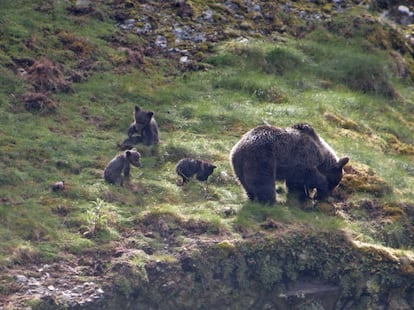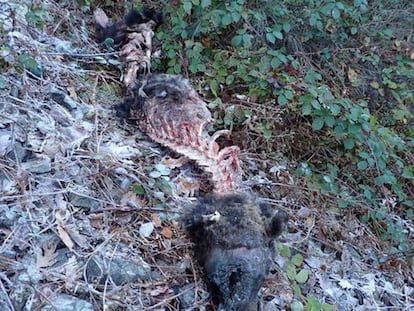The mystery of the brown bears in Spain¡¯s northern mountains
Nobody can figure out quite why the same species is growing better on the western side of the Cantabria range


The only brown bears who have managed to avoid extinction and thrive in Spain without the need to introduce foreign specimens are those that live in the mountains of Cantabria. They are distributed into two distinct populations, western and eastern, which have had different luck: in 2017 there were an estimated 250 bears in the western section, including 35 breeding females and 64 cubs, while in the eastern section this figure dropped to around 40 specimens, with six females and nine cubs, according to data from the regional government of Castilla y Le¨®n.
This year is proving to be especially tragic, with several dead bears found in the eastern side
Both groups are separated by a strip of land measuring between 50 and 80 kilometers. The other brown bear habitat, located in the Pyrenees, has 44 specimens and it is shared with neighboring France and the principality of Andorra. This third group was created by bringing in Slovenian brown bears from the same species (Ursus arctos arctos). The last indigenous bear, a female, died in 2004.
Despite years of study, it is still unclear why there is such a difference between the population growth of these two groups, which are distributed across the northern Spanish regions of Asturias, Galicia, Cantabria and Castilla y Le¨®n. Guillermo Palomero, president of Brown Bear Foundation (FOP), focuses on the habitat.

¡°The mountains of Palencia are less productive because of the type of food that is found there. In the fall season, the bears depend on the forests of oak and beech for subsistence, while in the western portion they also have chestnuts besides acorns. They have a better guarantee of surviving the winter,¡± he explains.

Palomero also recalls that when bear management began, there were more specimens in the western side. During the worst years there were between 50 and 60 specimens and at least 10 breeding females in the western side. In the eastern side, however, the population dropped to around 20 specimens and no more than two breeding females, a situation that encouraged inbreeding.
The non-profit group Fund for the Protection of Wild Animals (Fapas), which works on bear conservation in the Cantabria mountains, warns that mortality rates are higher in the eastern side.
¡°There is a constant trickle of deaths tied to hunting. If these were natural deaths, the bodies would not be located, because these animals always hide when they are hurt or sick,¡± says Roberto Hartas¨¢nchez, president of Fapas. ¡°The landscape is less rugged, and if you create trails, as has happened here, you reduce the number of places where the bears can take refuge. And bears need quiet places.¡±
This year is proving to be especially tragic, with several dead bears found in the eastern side. ¡°We are waiting for the results of the necropsies, if we get them, because you can¡¯t lose that many bears just like that, in one blow,¡± says the head of FOP, who nevertheless rules out hunting or poaching.
Goal: radio-marking
The main goal of the Higher Council of Scientific Research (CSIC) researchers is to obtain authorization for a radio-marking campaign that they say will be instrumental in obtaining more specific data about the species. ¡°It is not possible to develop a management program without knowing what your starting point is,¡± warns researcher Vicenzo Penteriani.
The conservationist Roberto Hartas¨¢nchez, president of the non-profit group Fund for the Protection of Wild Animals (Fapas), agrees, because "it would provide fantastic information."
At Fapas, however, experts say that specimens should be selected for radio-marking in order to find solutions to specific problems. ¡°But this is a taboo subject, because a similar project was launched 20 years ago and it went badly,¡± explains Penteriani. A bear died just a few days after being captured for radio-marking inside Somiedo Natural Park, in Asturias, and a controversy broke out over the practice.
For four years, a group of researchers from the Higher Council of Scientific Research (CSIC) and Oviedo University has been studying the case of the Cantabria brown bear. Vicenzo Penteriani, who heads the team, feels that from the point of view of resources (both food and habitat), ¡°there is not enough of a difference to explain the differences in the growth of the species.¡± Besides, the females are similarly productive, which rules out fertility as a cause.
The FOP says its own research indicates that females in the Cantabria mountains do, in fact, have fewer cubs than is usual for the species. Again, western females win, with an average of 1.87 cubs per litter, compared with 1.5 cubs for the eastern females. FOP biologist Fernando Ballesteros explains that while their techniques may not be that sophisticated, so many years of field observation (since 1989), makes their own data ¡°very robust.¡±
Ballesteros adds that both groups are now mixing, with some western males entering the eastern territory, as hair and excrement samples have shown.
English version by Susana Urra.
Tu suscripci¨®n se est¨¢ usando en otro dispositivo
?Quieres a?adir otro usuario a tu suscripci¨®n?
Si contin¨²as leyendo en este dispositivo, no se podr¨¢ leer en el otro.
FlechaTu suscripci¨®n se est¨¢ usando en otro dispositivo y solo puedes acceder a EL PA?S desde un dispositivo a la vez.
Si quieres compartir tu cuenta, cambia tu suscripci¨®n a la modalidad Premium, as¨ª podr¨¢s a?adir otro usuario. Cada uno acceder¨¢ con su propia cuenta de email, lo que os permitir¨¢ personalizar vuestra experiencia en EL PA?S.
?Tienes una suscripci¨®n de empresa? Accede aqu¨ª para contratar m¨¢s cuentas.
En el caso de no saber qui¨¦n est¨¢ usando tu cuenta, te recomendamos cambiar tu contrase?a aqu¨ª.
Si decides continuar compartiendo tu cuenta, este mensaje se mostrar¨¢ en tu dispositivo y en el de la otra persona que est¨¢ usando tu cuenta de forma indefinida, afectando a tu experiencia de lectura. Puedes consultar aqu¨ª los t¨¦rminos y condiciones de la suscripci¨®n digital.










































